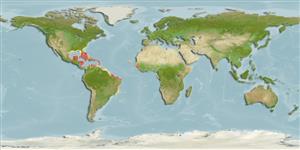分類 / Names
俗名 | 同種異名 | Catalog of Fishes(屬, 種) | ITIS | CoL | WoRMS | Cloffa
Teleostei >
Blenniiformes (Blennies) >
Labrisomidae (Labrisomids)
Etymology: Malacoctenus: Greek, malakos = soft + Greek, kteis, ktenos = comb (Ref. 45335).
Environment: milieu / climate zone / depth range / distribution range
生態學
海洋 礁區魚類; 深度上下限 0 - 40 m (Ref. 13121), usually 0 - 3 m (Ref. 9710). ; 32°N - 26°S, 100°W - 32°W
Southwestern Atlantic: from Bahamas and Florida southwards to Brazil.
大小 / 重量 / 年齡
Maturity: Lm ? range ? - ? cm
Max length : 7.5 cm TL 雄魚/尚未辨別雌雄; (Ref. 13628)
簡短描述
檢索表 | 型態特徵 | 形態測量圖
背棘 (總數) : 20 - 21; 背的軟條 (總數) : 11 - 12; 臀棘: 2; 臀鰭軟條: 20 - 22. With 3-5 dark brownish-red bands in form of inverted triangles along side. No other labrisomid has this distinctive color pattern (Ref. 26938). Head with a few small dark spots; bars on body sometimes not very dark but outlined by dark bars; scattered dots then often present elsewhere on the body (Ref. 13442).
Inhabits coral reefs and rocky shores. Often found in crevices, or among weed and rubble (Ref. 13121). Feeds on crustaceans (Ref. 13628).
Life cycle and mating behavior
Maturities | 繁殖 | Spawnings | Egg(s) | Fecundities | 仔魚
Robins, C.R. and G.C. Ray, 1986. A field guide to Atlantic coast fishes of North America. Houghton Mifflin Company, Boston, U.S.A. 354 p. (Ref. 7251)
人類使用
漁業: 商業性; 水族館: 商業性
工具
特別的報告
下載 XML
網路資源
Estimates based on models
Preferred temperature (Ref.
123201): 26.3 - 28.2, mean 27.5 °C (based on 645 cells).
Phylogenetic diversity index (Ref.
82804): PD
50 = 0.5000 [Uniqueness, from 0.5 = low to 2.0 = high].
Bayesian length-weight: a=0.00912 (0.00399 - 0.02083), b=3.06 (2.87 - 3.25), in cm total length, based on LWR estimates for this (Sub)family-body shape (Ref.
93245).
營養階層 (Ref.
69278): 3.5 ±0.50 se; based on food items.
Fishing Vulnerability (Ref.
59153): Low vulnerability (10 of 100).
Nutrients (Ref.
124155): Calcium = 75.4 [33.0, 164.9] mg/100g; Iron = 0.804 [0.436, 1.431] mg/100g; Protein = 19.4 [18.3, 20.5] %; Omega3 = 0.263 [0.143, 0.481] g/100g; Selenium = 10.5 [4.3, 22.4] μg/100g; VitaminA = 124 [37, 429] μg/100g; Zinc = 1.45 [0.88, 2.25] mg/100g (wet weight);
